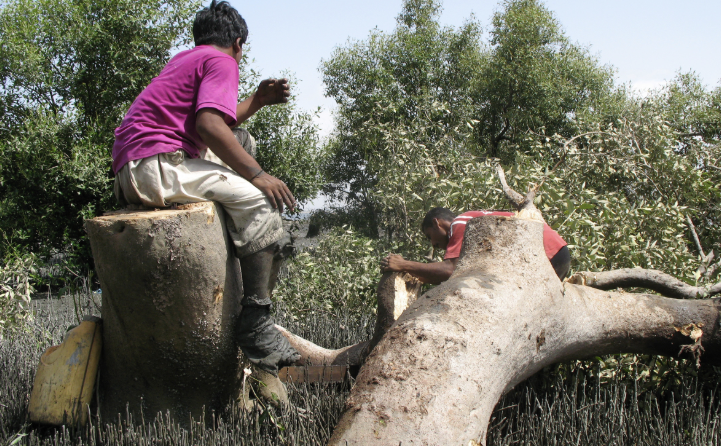Caught up in the maelstrom of divisive politics, India is silently but surely sliding into an environmental abyss under Mr. Modi’s watch. The latest EPI (Environmental Performance Index) report released on the sidelines of the WEF conclave at Davos puts us at third from the bottom- at 177 out of 180 countries, a decline of 36 places since 2016 (when we were at 141). We do even worse in the index of air quality, at 178 out of 180. The country is turning toxic in just about every indicator- its waters, air, pollution, health- but of particular concern is what the governments- centre and states- are doing do its green cover and forests.
According to a new study by the WRI (World Resources Institute) the country lost 1.6 million hectares of tree cover, and 16 million trees, between 2001 and 2018, of which 9.4 million trees were felled in just the last four years. In terms of climate change implications the effect of this large scale deforestation is disastrous: since each mature tree can absorb 22kg of carbon dioxide in a year, in four years we have added almost 900 million tonnes of carbon dioxide per year to our air (which could otherwise have been sequestered by these 9.4 million trees). But nobody in the government appears to be concerned, beyond regurgitating cooked up figures to show that our green cover is going up, not down, as all independent agencies stress. The UN has expressed reservations about our methodology for computing forest cover by including commercial plantations, orchards and taking a 2 meter height of trees instead of the internationally accepted figure of 5 meters. (Inspite of our fudging, the area under Moderately Dense Forests, which make up the bulk of the carbon sink, has declined by 10000 sq. kms between 2013 and 2019 (Forest Survey of India figures). But this is a standard operating procedure for this govt., whether on the economy, tiger count, crimes, suicides or anything that may reflect adversely on its performance.

The long term implications of what it is doing to the country’s forest cover, however, is extremely worrying. The UPA, for all its other faults, was alive to the imperative of protecting the natural environment and had put in place a robust mechanism to ensure this, including “no-go” areas for mining, the Forests Right Act, regulations for coastal zones, eco-zone buffers for Protected Areas, a National Green Tribunal (only the third in the world),etc. But the present BJP regime has devoted the last five years to dismantling this safety net to the point where the Ministry of Environment and Forest is but a pet poodle on a tight leash, tasked with ensuring “ease of business” rather than saving the environment. Two recent proposals will further decimate the environment.
Under the garb of strengthening compensatory afforestation it has proposed to allow “production forests” or commercial plantations in degraded forest areas, under the PPP route. This is nothing but an insidious attempt to favour private entities and to manipulate the forest cover figures. It is an attempt to monetise forests and a failure to recognise that forests provide not only timber but also bio-diversity, water, livelihood for tribals, which will be at grave risk from the monoculture nature of commercial plantations. It will also fragment continuous blocks of forests, disturbing wildlife and their corridors, and allow the ingress of “outsiders” with the resultant fall out of poaching, theft of NTFP, etc.
Instead of coming out with a revised forest policy to replace the current 1988 policy which cannot cope with today’s challenges, the govt. is instead initiating ad-hoc measures to allow further commercial intrusion into pristine native forests. A prime example is the Saranda- Chaibasa forests in Jharkhand’s Singbhum district- India’s largest contiguous Sal tract spread over 82000 hectares or 820 square miles. Not only does it function as a huge carbon sink, it has abundant bio-diversity, wildlife and is a source for livelihood for marginalised tribals. Discounting these concerns, the govt. has now sought a reassessment and review of its mining plan, earlier prepared by ICFRE which had classified it as a no-go area for mining. This will open the doors to commercial exploitation of other swathes of forests for mining, power and other projects.

Saranda-Chaibasa is not an isolated case: 500 projects in forests and Protected Areas have been cleared by the National Wildlife Board between 2014 and 2018, which is one reason why the country has lost 120000 hectares of primary forest in the last five years. Other examples of similar desecration are:
- Diversion of 1038 hectares of forest land in Sambalpur and Jharsuguda districts of Odisha for an NLC/ Adani coal mining project. This involves felling of 1.30 lakh trees (of which 40000 have already been felled) and displacement of 1894 tribal families. The villagers allege that the mandatory Gram Sabha consent has been forged.
- In the Western Ghats of Karnataka 2 million trees are at risk from 20 power projects. These include a 2000MW power project in the Sharavathy valley sanctuary, one of the last remaining habitats of the lion tailed macaque, an IUCN notified endangered species. 500 acres of verdant tropical forests are being diverted for the purpose. Another 150 acres is being denuded in the Anshi National Park in the Eco-sensitive Zone of the Ghats, and 177 hectares adjacent to the Kali tiger reserve, for a power line.
- 106000 trees will be felled, and 14 natural lakes filled in, for the Jewar airport in NOIDA in the Delhi NCR area, already perhaps the most polluted tract in the world.
- The Hasdeo Anand forests in Chattisgarh stretch for 170000 hectares and are perhaps the last remaining contiguous forest patches in central India. They provide environmental services and values which are incalculable in mere monetary terms. 30 coal blocks have been identified within it but till now it was a “no-go” area for mining. The BJP govt., however, true to form has now granted environmental clearance for open cast mining to commence on one of the blocks, Parsa, and has approved diversion of 841 hectares in the very heart of the forest. It will not be long before the other blocks are also taken up. This is the beginning of the end of these forests. Incidentally, guess which company will operate the mine? Rajasthan Collieries, Ltd.- a unit of Adani Enterprises Ltd.
Why are our governments and policy makers so blind to the world around us, and to the unfolding climate induced apocalypse waiting in the wings? As I’ve said before, the debate is no longer about striking a balance between development and the natural environment; that balance has already been skewed in favour of the former- the issue which we should now recognize is about restoring that balance. The world took a pledge at the recently concluded WEF at Davos to plant one trillion trees, and here we are, busily chopping down the ones that remain. Has Mr. Modi accomplished his environmental goals by claiming the Champion of the Earth award in 2018 at the UN? How on the same earth will he fulfill his grand announcement of reclaiming an additional 5 million hectares of degraded forest area by 2030? Or of sequestering an additional two billion tonnes of carbon dioxide by the same date?
Climate change and environmental disaster cannot be averted by fudging figures, winning awards or making tall promises. Unfortunately, till now we have had evidence of little else. What will it take to start saving our trees?
| The author retired from the IAS in December 2010. A keen environmentalist and trekker he has published a book on high altitude trekking in the Himachal Himalayas: THE TRAILS LESS TRAVELLED.
His second book- SPECTRE OF CHOOR DHAR is a collection of short stories based in Himachal and was published in July 2019. His third book was released in August 2020: POLYTICKS, DEMOCKRAZY AND MUMBO JUMBO is a compilation of satirical and humorous articles on the state of our nation. His fourth book was published on 6th July 2021. Titled INDIA: THE WASTED YEARS , the book is a chronicle of missed opportunities in the last nine years. Shukla’s fifth book – THE DEPUTY COMMISSIONER’S DOG AND OTHER COLLEAGUES- was released on 12th September 2023. It portrays the lighter side of life in the IAS and in Himachal. He writes for various publications and websites on the environment, governance and social issues. He divides his time between Delhi and his cottage in a small village above Shimla. He blogs at http://avayshukla.blogspot.in/ |


